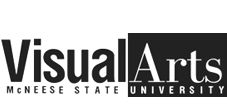|
Without the benefit of knowing
the artists, the full intent of the work, or the context or
ideas that inform the artists’ decisions, as a juror, all I can
do is rely on my eye and curatorial experience to select objects
that are, in my opinion, the most compelling and which deserve
closer examination. This is often a very difficult task
especially when the field of entries was as strong as is this
year’s 21st Annual McNeese National Works on Paper Exhibition.
Initially presented with images of several hundred works on
paper made by artists from across the country, I narrowed the
group to a still hefty exhibition of forty works which I felt
were particularly well conceived and executed. These exceptional
works demonstrate the high level of quality and ambition of
works being made on paper by artists from near, far, and some
areas in between. A quick look through the list of participating
artists proves that strong works are being made from coast to
coast, from large metropolitan areas like Los Angeles, Brooklyn,
and Chicago to smaller, less well-known regional artistic
centers like Topeka, Tuscaloosa, and Little Rock, among many
others. Thus, the exhibition serves an important purpose—as a
platform for showing us works from just about everywhere, it
shows us how artistic innovation and expression knows no
borders, and perhaps introduces us to artists and works we may
not have had an opportunity to see before. I am, personally,
delighted with the opportunity to have had the chance to become
familiar with them.
As is true of most juried exhibitions, the styles and themes of
the works on display in this year’s National Works on Paper
Exhibition run the gamut. However, what seems to unite them all,
in my opinion, is a sense of sincere engagement with the world
we live in today. Some artists seem to be responding to the
political and social issues of our times, others look to the
body and how it is represented through history or mass media,
and still others delve into the realm of abstraction as a way of
expressing emotion and meaning. Many address these issues
directly, while others veil their works in fantasy, fiction, or
historical reference. Together, these works speak volumes about
who we are as a society and culture. At the same time, these
works also demonstrates a keen understanding of formal issues,
including the use of light, color, and composition. One of the
most interesting aspects revealed to me in this group was how
these particular artists have pushed the boundaries regarding
paper’s materiality and use—demonstrating once again how
important paper is to every artist’s imagination.
Elizabeth Dunbar
Curator
Arthouse at the Jones Center
|
|



